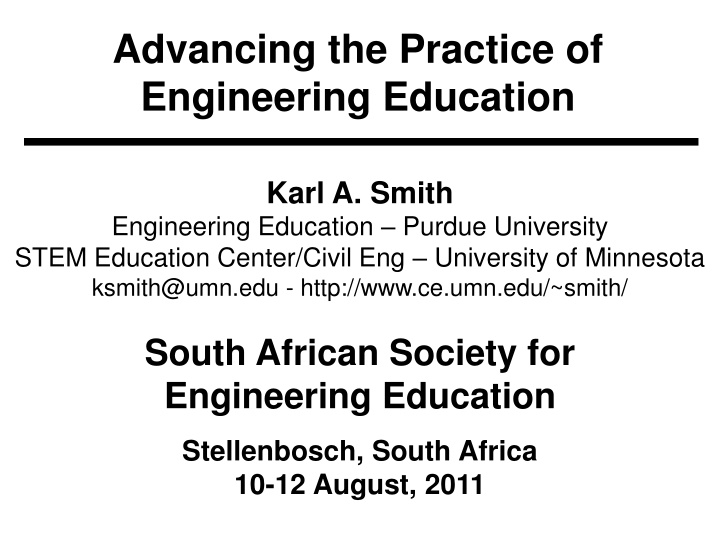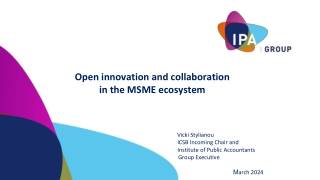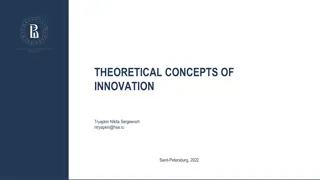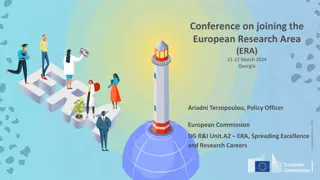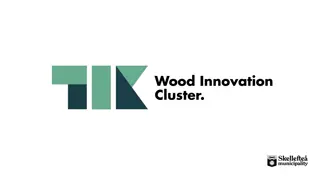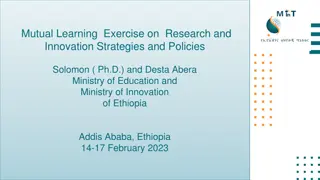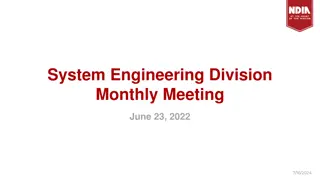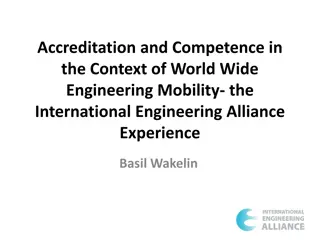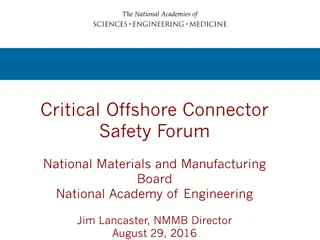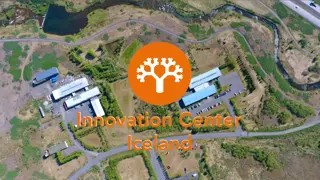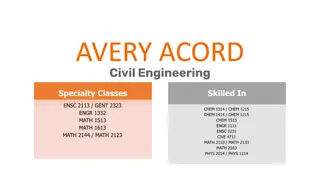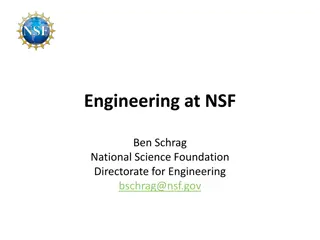Advancing Engineering Education: Embracing Innovation and Research
Karl A. Smith, from Purdue University, discusses advancing the practice of engineering education through innovative practices, research, and embracing engineering principles. The focus is on cultivating a loop between research and practice while exploring Rigorous Research in Engineering Education (RREE). Smith's expertise in Engineering Education Research & Innovation spans decades, from metallurgy processes to cooperative learning. Questions shaping the keynote revolve around bridging the gap between traditional engineering research and education.
Uploaded on Nov 12, 2024 | 1 Views
Download Presentation

Please find below an Image/Link to download the presentation.
The content on the website is provided AS IS for your information and personal use only. It may not be sold, licensed, or shared on other websites without obtaining consent from the author.If you encounter any issues during the download, it is possible that the publisher has removed the file from their server.
You are allowed to download the files provided on this website for personal or commercial use, subject to the condition that they are used lawfully. All files are the property of their respective owners.
The content on the website is provided AS IS for your information and personal use only. It may not be sold, licensed, or shared on other websites without obtaining consent from the author.
E N D
Presentation Transcript
Advancing the Practice of Engineering Education Karl A. Smith Engineering Education Purdue University STEM Education Center/Civil Eng University of Minnesota ksmith@umn.edu - http://www.ce.umn.edu/~smith/ South African Society for Engineering Education Stellenbosch, South Africa 10-12 August, 2011
Engineering A principal feature of the engineering method is advancing the state of the art (Koen, 2009). The engineering method is the use of heuristics to cause the best change in a poorly understood situation within the available resources (Koen, 1971, 2000) The engineering method is design under constraints Wm. Wulf, Past President, U.S. National Academy of Engineering
Questions Shaping the Keynote How do we embrace engineering principles in engineering education? How do we cultivate innovative practices in engineering education How do we close the loop between research and practice? What is the role of engineering education research? What is RREE, Rigorous Research in Engineering Education? How is it similar and different from traditional engineering research and practice?
Engineering Education Research & Innovation Karl Smith Research Process Metallurgy 1970 -1992 Learning ~1974 Design ~1995 Engineering Education Research & Innovation ~ 2000 Innovation Cooperative Learning Need identified ~1974 Introduced ~1976 FIE conference 1981 JEE paper 1981 Research book 1991 Practice handbook 1991 Change paper 1998 Teamwork and project management 2000 JEE paper 2005 National Academy of Engineering - Frontiers of Engineering Education Symposium - December 13-16, 2010 - Slides PDF [Smith-NAE-FOEE-HPL-UbD-12-10-v8.pdf]
Process Metallurgy Dissolution Kinetics liquid-solid interface Iron Ore Desliming solid-solid interface Metal-oxide reduction roasting gas- solid interface
Dissolution Kinetics Theory Governing Equation for Mass Transport Research rotating disk Practice leaching of silver bearing metallic copper = 2 ( ) c v D c 2 dc d c = vy D 2 dy dy
Iron Ore Desliming Theory DLVO [V(h) = VA(h) + VR(h)] Research streaming potential Practice recovery of iron from low- grade Fe2O3 ores (Selective removal of silicates)
Metal Oxide Reduction Roasting Theory catalyzed gas-solid reactions Boudouard Reaction [CO2 + C = 2CO] Research method thermogravimetric analysis Practice extraction of Ti from FeTiO3, Al from Al2O3 bearing minerals
First Teaching Experience Practice Third-year course in metallurgical reactions thermodynamics and kinetics
Engineering Education Practice Third-year course in metallurgical reactions thermodynamics and kinetics Research ? Theory ? Theory Research Practice
University of Minnesota College of Education Social, Psychological and Philosophical Foundations of Education Statistics, Measurement, Research Methodology Assessment and Evaluation Learning and Cognitive Psychology Knowledge Acquisition, Artificial Intelligence, Expert Systems Social psychology of learning student student interaction
Cooperative Learning Theory Social Interdependence Lewin Deutsch Johnson & Johnson Research Randomized Design Field Experiments Practice Formal Teams/Professor s Role Theory Research Evidence Practice
Cooperative Learning Positive Interdependence Individual and Group Accountability Face-to-Face Promotive Interaction Teamwork Skills Group Processing [*First edition 1991]
Cooperative Learning Research Support Johnson, D.W., Johnson, R.T., & Smith, K.A. 1998. Cooperative learning returns to college: What evidence is there that it works? Change, 30 (4), 26-35. Over 300 Experimental Studies First study conducted in 1924 High Generalizability Multiple Outcomes Outcomes 1. Achievement and retention 2. Critical thinking and higher-level reasoning 3. Differentiated views of others 4. Accurate understanding of others' perspectives 5. Liking for classmates and teacher 6. Liking for subject areas 7. Teamwork skills January 2005 March 2007
Cooperative Learning is instruction that involves people working in teams to accomplish a common goal, under conditions that involve both positive interdependence (all members must cooperate to complete the task) and individual and group accountability (each member is accountable for the complete final outcome). Key Concepts Positive Interdependence Individual and Group Accountability Face-to-Face Promotive Interaction Teamwork Skills Group Processing http://www.ce.umn.edu/~smith/docs/Smith-CL%20Handout%2008.pdf
The Active Learning Continuum Problems Drive the Course Structured Team Activities Informal Group Activities Make the lecture active Instructor Centered Student Centered Active Learning Collaborative Learning Problem- Based Learning Cooperative Learning My work is situated here Cooperative Learning & Challenge-Based Learning Prince, M. (2010). NAE FOEE
Problem-Based Cooperative Learning 27 January 13, 2009 New York Times http://www.nytimes.com/2009/01/13/us/13physics.html?em
http://mediamill.cla.umn.edu/mediamill/embed/78755 http://www1.umn.edu/news/news- releases/2010/UR_CONTENT_248261.html 30
Cooperative Learning Adopted The American College Teacher: National Norms for 2007-2008 Methods Used in All or Most Cooperative Learning Group Projects All 2005 48 All 2008 59 Assistant - 2008 66 33 36 61 Grading on a curve Term/research papers 19 17 14 35 44 47 32 http://www.heri.ucla.edu/index.php
Celebration of Two Major ASEE Milestones 2011 ASEE Annual Conference and Exposition Vancouver, British Columbia Monday, June 27, 2011
One BIG Idea; Two Perspectives Jamieson & Lohmann (2009) Engineering Education Innovation
ASEE Main Plenary, 8:45 a.m. 10:15 a.m. Vancouver International Conference Centre, West Ballroom CD Expected to draw over 2,000 attendees, this year s plenary features Karl A. Smith, Cooperative Learning Professor of Engineering Education at Purdue University and Morse Alumni Distinguished Teaching Professor & Professor of Civil Engineering at the University of Minnesota. Smith has been at the University of Minnesota since 1972 and has been active in ASEE since he became a member in 1973. For the past five years, he has been helping start the engineering education Ph.D. program at Purdue University. He is a Fellow of the American Society for Engineering Education and past Chair of the Educational Research and Methods Division. He has worked with thousands of faculty all over the world on pedagogies of engagement, especially cooperative learning, problem-based learning, and constructive controversy. On the occasion of the 100th anniversary of the Journal of Engineering Education and the release of ASEE s Phase II report Creating a Culture for Scholarly and Systematic Innovation in Engineering Education (Jamieson/Lohmann report), the plenary will celebrate these milestones and demonstrate rich, mutual interdependences between practice and inquiry into teaching and learning in engineering education. Depth and range of the plenary will energize the audience and reflects expertise and interests of conference participants. One of ASEE s premier educators and researchers, Smith will draw upon our roots in scholarship to set the stage and weave the transitions for six highlighted topics selected for their broad appeal across established, evolving, and emerging practices in engineering education.
Innovation is the adoption of a new practice in a community - Denning & Dunham (2010)
1. What is the distribution of innovations? 2. Did it change over time? If so, how? 3. Where does your innovation fit?
It could well be that faculty members of the twenty-first century college or university will find it necessary to set aside their roles as teachers and instead become designers of learning experiences, processes, and environments. James Duderstadt, 1999 [Nuclear Engineering Professor; Dean, Provost and President of the University of Michigan]
*R.M. Felder and R. Brent. (2003). Designing and Teaching Courses to Satisfy the ABET Engineering Criteria. J. Engr. Education, 92(1), 7 25. 44
Content-Assessment-Pedagogy (CAP) Design Process Flowchart Understanding by Design (Wiggins & McTighe, 2005) Start Context Content Backward Design Assessment Pedagogy C & A & P Alignment? No Yes End 45 Streveler, Smith & Pilotte (2011)
https://engineering.purdue.edu/Engr/Academics/Engineer2020/?pp=1https://engineering.purdue.edu/Engr/Academics/Engineer2020/?pp=1
Desired Attributes of a Global Engineer* A multidisciplinary, systems perspective, along with a product focus An awareness of the boundaries of one s knowledge, along with an appreciation for other areas of knowledge and their interrelatedness with one s own expertise An awareness of and strong appreciation for other cultures and their diversity, their distinctiveness, and their inherent value A strong commitment to team work, including extensive experience with and understanding of team dynamics High ethical standards (honesty, sense of personal and social responsibility, fairness, etc) An ability to think both critically and creatively, in both independent and cooperative modes *A Manifesto for Global Engineering Education, Summary Report of the Engineering Futures Conference, January 22-23, 1997. The Boeing Company & Rensselaer Polytechnic Institute.
Successful Attributes for the Engineer of 2020 Possess strong analytical skills Exhibit practical ingenuity; posses creativity Good communication skills with multiple stakeholders Business and management skills; Leadership abilities High ethical standards and a strong sense of professionalism Dynamic/agile/resilient/flexible Lifelong learners
Engineering Education Research Colleges and universities should endorse research in engineering education as a valued and rewarded activity for engineering faculty and should develop new standards for faculty qualifications.
Getting Started in Engineering Education Research Fundamentals of Engineering Education Research in partnership with Rigorous Research in Engineering Education Initiative CLEERhub.org And the Journal of Engineering Education sponsored by the ASEE Educational Research and Methods Division ASEE Annual Conference June 20, 2010 Session 0230 Karl A. Smith Purdue University and University of Minnesota Ruth A.Streveler Purdue University
Levels of Engineering Education Inquiry Level 0Teacher Teach as taught ( distal pedagogy ) Level 1 Effective Teacher Teach using accepted teaching theories and practices Level 2 Scholarly Teacher Assesses performance and makes improvements Level 3 Scholar of Teaching and Learning Engages in educational experimentation, shares results Level 4 Engineering Education Researcher Conducts educational research, publishes archival papers Source: Streveler, R., Borrego, M. and Smith, K.A. 2007. Moving from the Scholarship of Teaching and Learning to Educational Research: An Example from Engineering. Improve the Academy, Vol. 25, 139-149.
Some history about this workshop Rigorous Research in Engineering Education (RREE1) One-week summer workshop, year-long research project Funded by National Science Foundation (NSF), 2004-2006 About 150 engineering faculty participated Goals Identify engineering faculty interested in conducting engineering education research Develop faculty knowledge and skills for conducting engineering education research (especially in theory and research methodology) Cultivate the development of a Community of Practice of faculty conducting engineering education research
RREE Approach Theory (study grounded in theory/conceptual framework) Research that makes a difference . . . in theory and practice Research Evidence (appropriate design and methodology) Practice (implications for teaching) http://inside.mines.edu/research/cee/ND.htm
Guiding Principles for Scientific Research in Education Question: pose significant question that can be investigated empirically Theory: link research to relevant theory Methods: use methods that permit direct investigation of the question Reasoning: provide coherent, explicit chain of reasoning Replicate and generalize across studies Disclose research to encourage professional scrutiny and critique 1. 2. 3. 4. 5. 6. National Research Council, 2002
Research can be inspired by Use (Applied) No Yes Use-inspired basic research Pure basic research (Bohr) (Pasteur) Yes Understanding (Basic) Pure applied research (Edison) No Source: Stokes, D. 1997. Pasteur s quadrant: Basic science and technological innovation. Washington, DC: Brookings Institution. Source: Stokes, D. 1997. Pasteur s quadrant: Basic science and technological innovation. Washington, DC: Brookings Institution.
Research Process Practical Problem and helps motivates Research Answer Research Question leads to informs Warrant Research Problem Claim Reason Evidence Research Process Acknowledgment and Response Research Reasoning
RREE2 Follow-up proposal has been awarded (RREE2) Includes a series of 5 short courses* Fundamentals of Engineering Education Research Selecting Conceptual Frameworks Understanding Qualitative Research Designing Your Research Study Collaborating with Learning and Social Scientists *To be recorded and posted on the CLEERhub.org
Status of RREE Project EER workshops and EER JEE Collaboration Fundamentals of Educational Research ASEE 2010 - FIE 2010 - SASEE 2011 Selecting Conceptual Frameworks for Engineering Education Research RCEE/UTM Malaysia 2010 - ASEE 2010 Understanding Qualitative Research FIE 2010 Designing Your Research Study ASEE 2011 Collaboratory for Engineering Education Research (CLEERhub.org)
An emerging global community Groups, centers, departments Engineering education societies Forums for dissemination What follows is a sample it is NOT an exhaustive list!
Groups, centers, departments EERG UCPBLEE ESC ELC Purdue CRLT North CASEE CELT Utah St VT FIC Clemson UTM UDLAP NITTT&R CREE UICEE Engineering Teaching and Learning Centers Australia: UICEE, UNESCO International Centre for Engineering Education; Denmark: UCPBLEE, UNESCO Chair in Problem Based Learning in Engineering Education; South Africa: CREE, Centre for Research in Engineering Education, U of Cape Town; Sweden: Engineering Education Research Group, Link ping U; UK: ESC, Engineering Subject Centre, Higher Education Academy; USA: CELT, Center for Engineering Learning and Teaching, U of Washington; CRLT North, Center for Research on Learning and Teaching, U of Michigan; Faculty Innovation Center, U of Texas-Austin; Engineering Learning Center, U of Wisconsin-Madison; CASEE, Center for the Advancement of Scholarship in Engineering Education, National Academy of Engineering. Engineering Education Degree-granting Departments USA: School of Engineering Education, Purdue U; Department of Engineering Education, Virginia Tech; Department of Engineering and Science Education, Clemson U; Department of Engineering and Technology Education, Utah State U; Malaysia: Engineering Education PhD program, Universiti Teknologi Malaysia; India: National Institute for Technical Teacher Training and Research; Mexico: Universidad de las Americas, Puebla
Engineering education societies Societies with Engineering Education Research Groups ASEE, American Society for Engineering Education, Educational Research Methods Division; SEFI, Soci t Europ enne pour la Formation des Ing nieurs (European Society for Engineering Education), Engineering Education Research Working Group; Australasian Association for Engineering Education, Engineering Education Research Working Group; Community of Engineering Education Research Scholars, Latin America and Caribbean Consortium for Engineering Institutions Societies with Engineering Education Research Interests Indian Society for Technical Education, Latin American and Caribbean Consortium of Engineering Institutions, Asociaci n Nacional de Facultades y Escuelas de Ingenier a (National Association of Engineering Colleges and Schools in Mexico), Internationale Gesellschaft f r Ingenieurp dagogik (International Society for Engineering Education), International Federation of Engineering Education Societies, South African Engineering Education Association (SASEE)
